In this article, we’ll demo 6 of our chatbot offerings for the pet care industry. Cover commonly encountered challenges in the industry and how we address them through AI & ChatGPT, GPT4.
As pet ownership rises and pet owners desire more convenient and customized experiences, chatbots are being integrated into the pet care industry. But the top three challenges- economy, Assortment reduction, and growth of premium brands in 2023- impact the industry. Can chatbots solve these issues?
Ionio is already empowering the pet industry leaders with AI integration into their workflow. In this article, we will dig deep and help you discover 8 potential ways to utilize chatbots for pet brands.
Keep on reading!

Challenges Pet Industry Facing in 2023
The pet industry has indeed seen some best moments in 2022, but there are some roadblocks this industry is facing now.
Price increase
Inflation and consumer fear of a recession ripple through any sector. Pet food costs increase by an average of $0.30 in 2022.Veterinarians.org's Special Reports Team found that pet owners in the United States struggle to make ends meet while caring for their human, canine, and equine family members in the face of rising prices. The cost of necessities like food, materials, and medical care has skyrocketed over the last 14 months.

Half of the 1,000 pet owners surveyed said they had to go elsewhere for affordable pet food, and 55% said they had to discontinue pet food subscriptions with sites like Chewy and Amazon.
Reduction in Assortment
Many pet product businesses reduce their product selection with price hikes to maintain profit margins and prevent stockouts. The number of universal product codes (UPCs) for pet food fell by 2.4% in 2022.1 For the first time in almost four years, assortment sales have fallen. Consequently, several popular pet food manufacturers wonder whether they should continue offering their whole line of goods.

Massification of premiums
Due to the proliferation of high-end pet food retailers, the market has undergone a "mass premiumization." Once solely sold at pet speciality stores, several types of pet food are now widely available in supermarkets. Additionally, internet-based businesses further muddy the waters between pet speciality and mass-market channels. Online stores like Amazon and Chewy provide a wide selection of pet food at different prices. Additionally, private-label pet meals sold by online merchants now go head-to head-with national names in this industry.
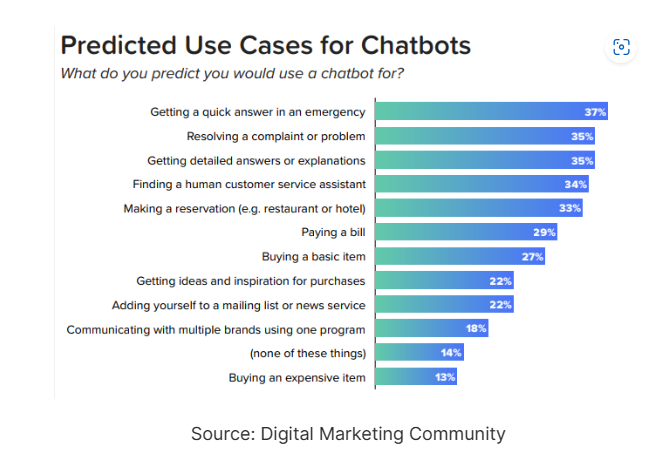
Is Chatbot The Solution That The Pet Industry Looking For?
Here are some possible ways a chatbot can help the Pet-related business
Better Participation from Customers
A chatbot may have a conversation in real-time with pet owners, providing them with immediate support and data. It may help with things like finding a new home for a pet, getting it groomed, or organizing a visit to the doctor by answering common queries and making suggestions. Customer happiness and loyalty may both increase with this kind of involvement.
Accessible At All Hours
Unlike more conventional customer service forms, which have set hours, a chatbot is available whenever a user needs it. This is incredibly convenient for pet owners who may have pressing questions outside of office hours or want rapid assistance. The chatbot can answer questions, provide simple instructions, and even link people to 911 if needed.
Improved Efficiency
The chatbot may help pet stores save time and effort by taking over repetitive chores like scheduling appointments. It can quickly and easily collect data, provide alternatives, and complete reservations. This results in less labor for employees, fewer opportunities for human mistakes, and a more pleasant experience for consumers and merchants alike.
Cost-effectiveness and scalability
There is no need to hire extra help while using a chatbot since it can manage numerous chats at once. Because of its scalability, pet supply stores can more easily respond to customers' questions and concerns. There is less need for firms to maintain large customer service departments when a chatbot is in place, freeing up resources for other uses.
8 ways a Pet Care Chatbot reshaping the industry
Here are 8 ways petcare chatbots are impacting the industry
Finding out dog/ cat breeds breeds
If you don't know the breed of a dog or cat, it can make it difficult to understand certain aspects of their behavior, temperament, and specific needs. Different breeds have distinct characteristics, energy levels, exercise requirements, grooming needs, and potential health issues. Knowing the breed can help you provide appropriate care, training, and enrichment activities for your pet.
For example, let's say you have a dog and need to figure out their breed. They may exhibit certain behaviors that are common in specific breeds.
If your dog is highly energetic, intelligent, and loves to fetch, it might have traits of a Border Collie or a Labrador Retriever. Understanding this can help you engage them in activities that cater to their instincts, such as agility training or interactive games.
On the other hand, if your dog has a brachycephalic (short-nosed) breed like a Bulldog or a Pug, you'll be aware that they may be more prone to respiratory issues and need special care during hot weather or strenuous exercise.
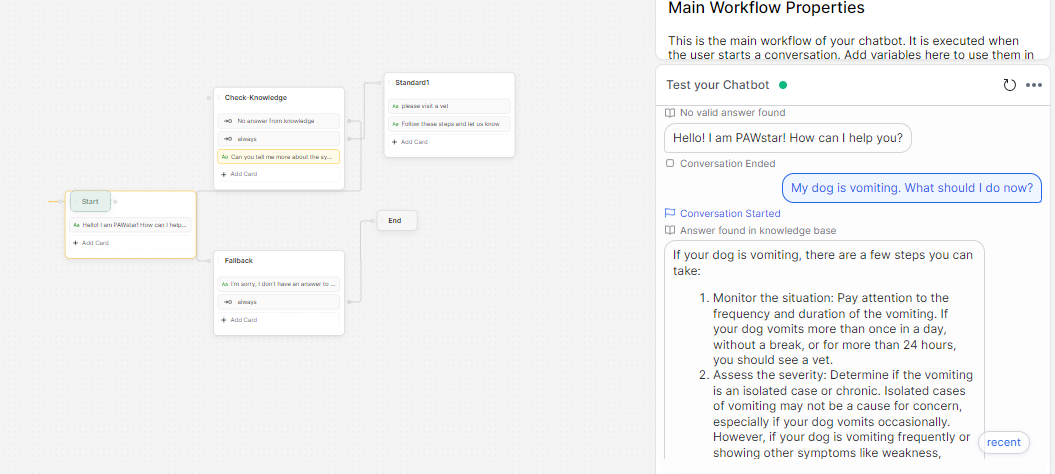
A chatbot can help you identify the dog or cat breeds based on their physical characteristics, behavior traits, or any available information you provide. You can describe the animal's appearance, size, coat color, texture, and distinct features or behaviors. It can then offer suggestions on potential breeds that match those characteristics.
For instance, if you describe a dog with a small size, long fluffy fur, and friendly and independent temperament, the chatbot might suggest breeds like the Shih Tzu or the Lhasa Apso.
By helping you narrow down the possibilities, a chatbot can assist you in gaining insights into the potential breed traits, which can help you understand and meet your pet's specific needs.
Provide instant access to pet health and wellness advice
When unforeseen events arise or when there are worries about their pet's health, pet owners frequently require immediate access to relevant resources. A chatbot can be a great help in these kinds of situations.
A dog parent discovers their pet is vomiting, with symptoms like listlessness, inappetence, and a runny nose. They worry about their cat's health but aren't sure whether it warrants scheduling a medical visit. A chatbot programmed to answer questions about pet health will be helpful in this case.
The pet parent can communicate through a chatbot. They can explain their dog's condition and get recommendations on how to proceed. The chatbot will inquire with pertinent follow-up questions and provide instantaneous recommendations based on its pre-programmed expertise.
The chatbot inquires as to the feline's allergy history, recent exposure to new locations, or any changes in habit, among other things. In addition, it provides them with a broad overview of the most prevalent feline health problems, such as respiratory infections, allergies, and more.
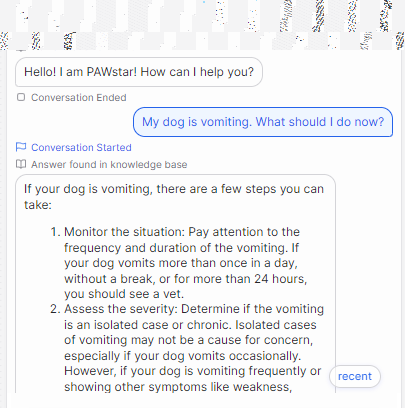
Based on the collected data, the chatbot suggests to the pet owner, such as keeping an eye on the cat for the next day or two, giving the animal over-the-counter medication if necessary, or urging the pet owner to see the clinic immediately. In the meanwhile, the chatbot can provide advice on how to make the dog more at ease.
Pet owners with a chatbot on hand get fast advice and assistance, easing their minds and preventing them from making unneeded trips to the clinic. While waiting for vet help or in less urgent circumstances, the chatbot can be relied upon as a trustworthy information resource.
Offer personalized product recommendations based on the pet's needs
Personalized products are becoming more popular in the realm of Internet shopping. However, this goes beyond tailor-made web pages and curated product sets in the food industry. Modern shoppers seek brands catering to their dietary preferences and health concerns. Pet owners are increasingly interested in individualized diets for their animals, just as they do for themselves. As a result, more and more companies are producing pet food that caters to individual pets by providing them with specialized diets and nutritional supplements.
A chatbot can serve as a virtual assistant, guiding pet owners through finding the most suitable products for their pets. By conversing with the chatbot, they can provide information about their pet's breed, age, size, dietary restrictions, and health concerns. The chatbot, equipped with a vast database of pet products and their attributes, can analyze the input and generate personalized recommendations tailored to the pet's needs.
The personalized nature of the recommendations offered brings several advantages. Firstly, it saves pet owners time and effort researching and comparing different products. Instead of browsing numerous websites or seeking advice from various sources, they can rely on the chatbot to provide accurate and relevant suggestions based on their pet's specific requirements.
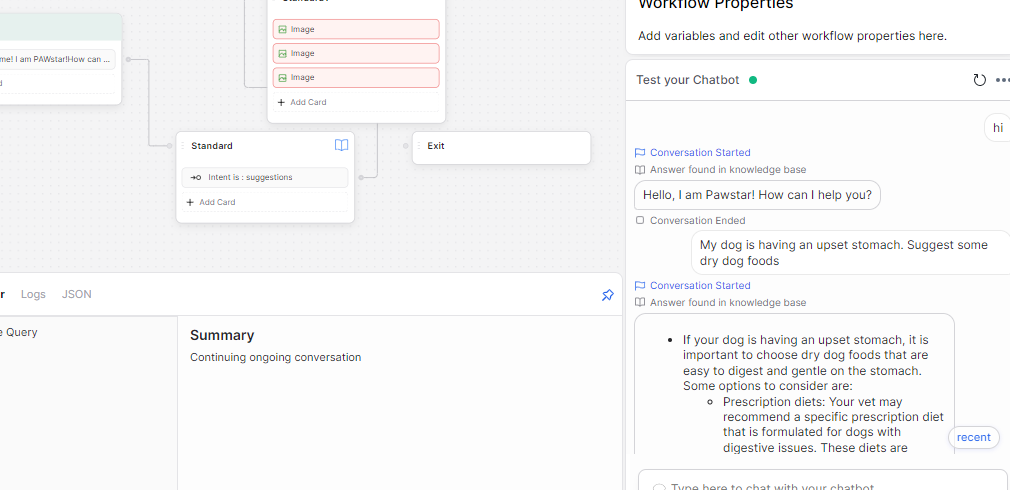
Additionally, the chatbot can help pet owners discover new and specialized products they may not be aware of. For instance, if a pet owner mentions that their dog has a sensitive stomach, the chatbot can recommend high-quality, easily digestible food brands specifically formulated for dogs with similar conditions.
Assist with behavior training and provide tips for common issues
The pet industry can significantly benefit from the use of a chatbot to assist with behavior training and provide tips for common issues. A chatbot explicitly designed for pet owners can serve as a convenient and accessible resource, offering guidance and support in real time.
One of the main reasons a chatbot is valuable in behavior training is its ability to provide consistent and reliable information. Pet owners often encounter issues such as house training, excessive barking, or separation anxiety. Instead of relying on scattered information from various sources, a chatbot can provide accurate and up-to-date advice tailored to the pet's and its owner's specific needs.
For example, imagine a dog owner struggling with their pet's excessive barking. They may need clarification about the underlying causes or how to address the behavior effectively. With a chatbot, they can engage in a conversation and describe the problem. The chatbot can then ask relevant questions to gather more details and provide customized tips based on established behavior training techniques.
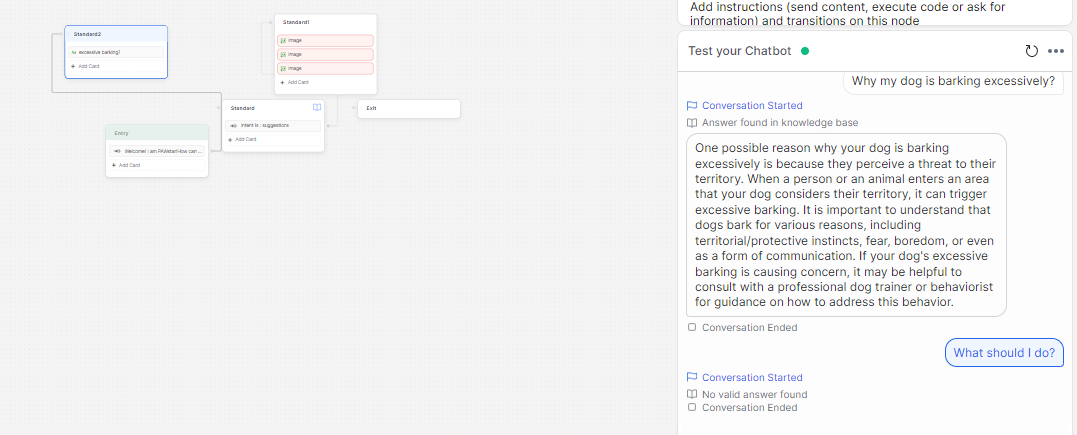
Depending on the severity and nature of the issue, it can suggest strategies like positive reinforcement, desensitization, or professional training recommendations. The chatbot can also offer additional resources, such as video tutorials or articles, to further assist the pet owner.
Offer guidance in emergencies and first aid instructions
In critical situations involving pets, quick and accurate information can be vital in ensuring the well-being and even the survival of the animal.
Imagine a pet owner finding their dog showing signs of poisoning. When people are in a crisis, they often lack the mental capacity to investigate the best course of action. A chatbot can instantly advise on how to assess the situation, diagnose toxicity, and provide basic first aid like vomiting or wiping the pet's mouth.
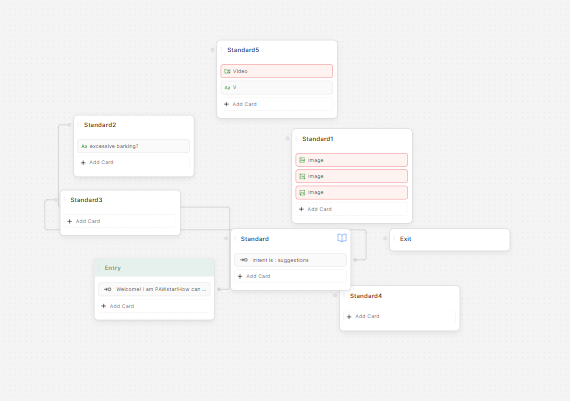
Moreover, the chatbot can offer step-by-step instructions for common pet emergencies, including choking, heatstroke, seizures, or injuries. It can educate pet owners on how to perform CPR, control bleeding, or stabilize fractures while they await professional veterinary care.
With a chatbot available, pet owners can access immediate assistance regardless of location or time of day. This 24/7 availability can be crucial when faced with an emergency where every second counts.
Assist with order placement, tracking, and managing subscriptions
Implementing a chatbot to help with order placing, monitoring, and subscription management would be a huge boon to the pet market. Due to the rise of subscription-based services and online pet shops, it is now more critical than ever for companies in this sector to give customers a pleasant and stress-free shopping experience. A chatbot helps pet owners in many ways, including automating routine activities and offering instantaneous assistance.
Using a chatbot to make an order is a time-saving and convenient option. Customers may search for items using the chat interface, get suggestions tailored to their pet's requirements, and even complete purchases. By providing information such as price, availability, and user reviews, the chatbot helps pet owners make educated purchases.
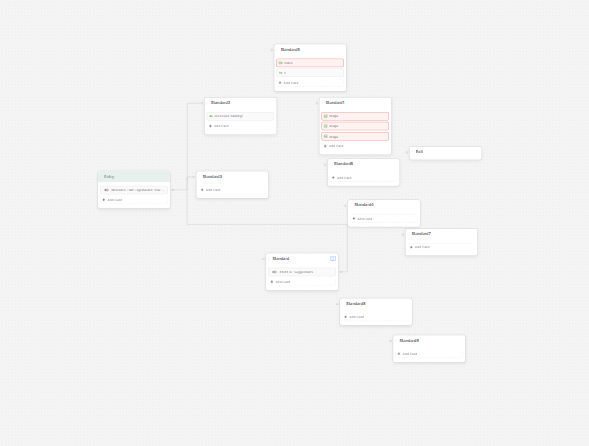
A chatbot's ease of use extends to purchase tracking. The chatbot can provide consumers with up-to-date information on the status and location of their purchases without them having to wade through sophisticated tracking systems or call customer care. Customers may get real-time updates by entering their order number or giving pertinent data, eliminating the need for manual tracking and decreasing consumer dissatisfaction.
A chatbot also makes it easier to manage recurring payments and subscriptions. Many people with pets use subscription services to ensure they always have access to food, medicine, and toys. Customers can easily update or cancel their subscriptions with the assistance of the chatbot.
Chatbot for animal adoption
Adoptable pet chatbots have the potential to revolutionize the pet market. An automated conversational agent chatbot may educate and engage with potential users. This technology might revolutionize pet adoption by simplifying, broadening, and improving efficiency.
To begin, a chatbot may be a simple resource for anyone interested in adopting animals. The chatbot may be accessed by users via various mediums, giving them access to data whenever and wherever they need it. If a user is interested in adopting an animal, the chatbot may provide information on the animal's breed, age, temperament, and health.
In addition, a chatbot may provide tailored suggestions for the user, depending on their tastes and needs. The chatbot may learn about the adopter's tastes, living circumstances, and daily routine via a series of questions and then recommend dogs that are a good fit. Adopters and shelters may benefit from this since it speeds up finding good homes for animals.

A chatbot may also help adoption by offering direction and fielding common inquiries. It may clarify and simplify the process by outlining what needs to be done, such as applying, gathering the required paperwork, and setting up appointments. The chatbot may also provide details on adoption costs, immunization histories, and spay/neuter procedures to ensure adopters are well-informed and prepared.
Grooming/ vet session booking
Pet owners often think it's good for their dogs' well-being and look to bathe them, brush them, and cut their nails. Forecasts indicate that the worldwide market for pet grooming will expand at a CAGR of 7.09 percent over the next several years. However, this was only sometimes the case; in 2020, pet grooming services fell.

In 2021, pet grooming saw an increase in demand; by 2022, it had skyrocketed. The pet grooming industry is on track for a full recovery and expansion in the next few years. That's why we included it as one of the 2023 pet industry trends: pet grooming. According to industry forecasts, the pet grooming market will reach $14.5 billion by 2025. About $50,000 will come from sales in the USA. The demand for pet shampoos and conditioners is anticipated to increase, contributing 52% of total sales.
Customers can access the chatbot 24/7 to arrange grooming or vet appointments without waiting for office hours or using phone calls or emails. Since the chatbot can handle many inquiries simultaneously, it can cut down on wait times and boost happy customers.
In addition, a chatbot could offer tailored suggestions for each pet based on its characteristics and requirements. To provide appropriate recommendations for grooming sessions, the chatbot may learn about the pet's breed, size, and preferred services ahead of time. The chatbot may ask about symptoms or concerns, classify them by urgency, and suggest convenient appointment times for veterinary visits.
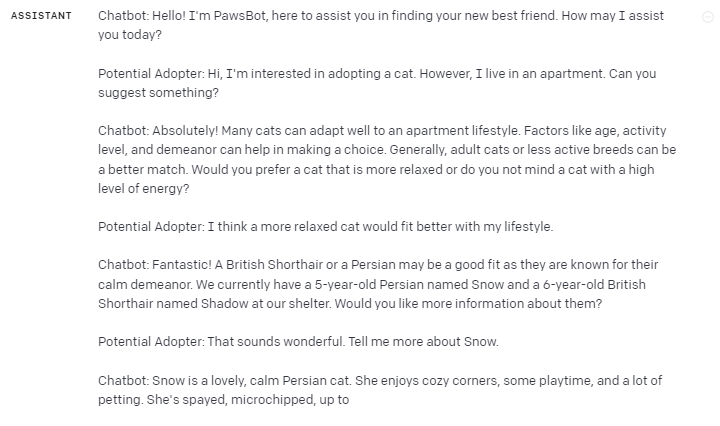
Booking appointments can be automated using a chatbot, saving time and effort for pet companies. Instead of spending much time on manual appointment scheduling, staff may provide more attention to the dogs in their care. The chatbot can also be linked to the company's booking software for seamless, real-time changes, cancellations, and reschedules.
Ready to Reap the Benefits?
Pet entrepreneurs can establish a seamless, customer-focused environment by blending automation with human warmth and knowledge. Improve productivity, consumer happiness, and the health of pets as technology advances. So now is the time to integrate a chatbot that can overcome industry challenges.
Let Ionio help you to pave the path to success. Book a call today with our CEO Rohan!


.png)




